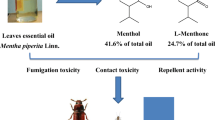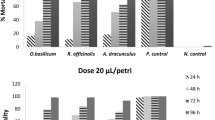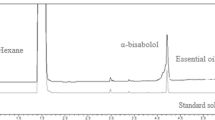Abstract
The biological activity of essential oil extracted from coriander, Coriandrum sativum L. (Apiaceae) against eggs, larvae and adults of Tribolium castaneum (Herbst) was investigated in a series of laboratory experiments. Bioassays conducted in air-tight glass chambers showed vapour toxicity and strong repellency on filter paper arena test towards all the stages used. Responses varied significantly (P < 0.001) within insect stages, dosages and exposures. At 12.0 μg/ml dosage, mortality of adults reached 95%, but for 12-, 14- and 16-days larvae, mortalities were 65, 74 and 82%, respectively. On the developmental inhibition, individuals fumigated at the larval stage confirmed that the percentage of larvae reaching to pupal stage and pupae to adult stage, decreased significantly (P < 0.001) with increasing dosage concentration. The oil fumigation yielded 100% mortality for T. castaneum larvae, pupae and adults at 0.08 μg/ml dosage. The oil had fumigant activity against eggs and the toxicity progressively increased with increased exposure times and concentrations. One hundred per cent T. castaneum egg mortalities were obtained with oil fumigation at 20 μg/ml and 96 h exposure period. C. sativum oil also showed highly repellent activity to the adults of T. castaneum, with overall repellency was 90% and at a dosage of 12 μg/ml repellency was 100% in a filter-paper arena test.



Similar content being viewed by others
References
Abbott WS (1925) A method of computing the effectiveness of an insecticide. J Econ Entomol 18:265–267
Champ BR, Dyte CE (1977) FAO global survey of pesticide susceptibility of stored grain pests. FAO Plant Prot Bull 25:49–67
Diederichsen A (1996) Coriander (Coriandrum sativum L.). Promoting the conservation and use of under-utilized and neglected crops. 3. Institute of Plant Genetics and Crop Plant Research, Gatersleben, International Plant Genetic Resources Institute, Rome
Don-Pedro KN (1996) Fumigant toxicity of citrus peel oils against adult and immature stages of storage insect pests. Pestic Sci 47:213–223. doi:10.1002/(SICI)1096-9063(199607)47:3<213::AID-PS372>3.0.CO;2-4
Dunkel FV, Sears LJ (1998) Fumigant properties of physical preparations from mountain big sagebrush, Artemisia tridentata Nutt. ssp. vaseyana (Rydb.) beetle for stored grain insects. J Stored Prod Res 34:307–321. doi:10.1016/S0022-474X(98)00015-0
Hori M (2003) Repellency of essential oils against the cigarette beetle, Lasioderma serricorne (Fabricius) (Coleoptera: Anobiidae). Appl Entomol Zool 38:467–473. doi:10.1303/aez.2003.467
Huang Y, Lam SL, Ho SH (2000) Bioactivities of essential oil from Elletaria cardamomum (L.) Maton. To Sitophilus zeamais Motschulsky and Tribolium castaneum (Herbst). J Stored Prod Res 36:107–117. doi:10.1016/S0022-474X(99)00040-5
Islam MS, Talukder FA (2005) Toxic and residual effects of Azadirachta indicia, Tagetes erecta and Cynodon dactylon seed extracts and leaf powders towards Tribolium castaneum. J Plant Dis Prot 112:594–601
Isman MB (2006) Botanical insecticides, deterrents, and repellents in modern agriculture and an increasingly regulated world. Ann Rev Ent 51:45–66. doi:10.1146/annurev.ento.51.110104.151146
Jilani G, Saxena RC, Rueda BP (1988) Repellent and growth inhibition effects of turmeric oil, sweetflag oil, neem oil and Margosan-O on red flour beetle (Coleoptera: Tenebrionodae). J Econ Entomol 81:1226–1230
Ketoh GK, Koumaglo HK, Glitho IA (2005) Inhibition of Callosobruchus maculatus (F.) (Coleoptera: Bruchidae) development with essential oil extracted from Cymbopogon schoenanthus L. Spreng. (Poaceae), and the wasp Dinarmus basalis (Rondani) (Hymenoptera: Pteromalidae). J Stored Prod Res 41:363–371. doi:10.1016/j.jspr.2004.02.002
Kim DH, Ahn YJ (2001) Contact and fumigant activities of constituents of Foeniculum vulgare fruit against three coleopteran stored-product insects. Pest Manag Sci 57:301–306. doi:10.1002/ps.274
Kim SI, Roh JY, Kim DH, Lee HS, Ahn YJ (2003) Insecticidal activities of aromatic plant extracts and essential oils against Sitophilus oryzae and Callosobruchus chinensis. J Stored Prod Res 39:293–303. doi:10.1016/S0022-474X(02)00017-6
Kim HK, Kim JR, Ahn YJ (2004) Acaricidal activity of cinnamaldehyde and its congeners against Tyrophagus putrescentiae (Acari: Acaridae). J Stored Prod Res 40:55–63. doi:10.1016/S0022-474X(02)00075-9
Kokate CK, D’Cruz JL, Kumar RA, Apte SS (1985) Anti-insect and juvenoidal activity of phytochemicals derived from Adbatoda pasica Nees. Indian J Nat Prod 1:7–9
Koul O (2004) Biological activity of volatile di-n-propyl disulfide from seeds of neem, Azadirachta indica (Meliaceae), to two species of stored grain pests, Sitophilus oryzae (L.) and Tribolium castaneum (Herbst). J Econ Entomol 97:1142–1147. doi:10.1603/0022-0493(2004)097[1142:BAOVDD]2.0.CO;2
Lee BH, Annis PC, Tumaalii F, Lee SE (2004) Fumigant toxicity of Eucalyptus blakelyi and Melaleuca fulgens essential oils and 1, 8-cineole against different development stages of the rice weevil Sitophilus oryzae. Phytoparasitica 32:498–506. doi:10.1007/BF02980444
Lόpez MD, Jordán MJ, Pascual-Villalobos MJ (2008) Toxic compounds in essential oils of coriander, caraway and basil active against stored rice pests. J Stored Prod Res 44:273–278
MacDonald LL, Guy RH, Speirs RD (1970) Preliminary evaluation of new candidate materials as toxicants, repellents and attractants against stored product insects. Marketing Research Report Number 882. Washington Agricultural Research, Service, US Department of Agriculture, p 8
Mateeva A, Karov S (1983) Studies on the insecticidal effect of some essential oils. Nauchni Tr Vissha Selskostopanski Inst ‘Vasil Kolarvo’ Plodiv 28:129–139
Mishra RC, Kumar J (1983) Evaluation of Mentha piperita L. oil as a fumigant against red flour beetle, Tribolium castaneum (Herbst). Indian Perfumer 27:73–76
Nawrot J, Harmatha J (1994) Natural products as antifeedants against stored product insects. Postharvest News Inf 5:17N–21N
Negahban M, Moharramipour S (2007) Fumigant toxicity of Eucalyptus intertexta, Eucalyptus sargentii and Eucalyptus camaldulensis against stored-product beetles. J Appl Entomol 131:256–261
Negahban M, Moharramipour S, Sefidkon F (2007) Fumigant toxicity of essential oil from Artemisia sieberi Besser against three stored-product insects. J Stored Prod Res 43:123–128
Obeng-Ofori D, Ch Reichmuth (1997) Bioactivity of eugenol, a major component of essential oil of Ocimum suave (Wild.) against four species of stored-product Coleoptera. Int J Pest Manag 43:89–94
Pascual-Villalobos MJ, Ballesta-Acosta MC (2003) Chemical variation in an Ocimum basilicum germplasm collection and activity of the essential oils on Callosobruchus maculatus. Biochem Syst Ecol 31:673–679
Rajendran S, Sriranjini V (2008) Plant products as fumigants for stored-product insect control. J Stored Prod Res 44:126–135
Regnault-Roger C (1997) The potential of botanical essential oils for insect pest control. Integr Pest Manag Rev 2:25–34
Ren YL, Mahona D, Gravera JVS, Head M (2008) Fumigation trial on direct application of liquid carbonyl sulphide to wheat in a 2500 t concrete silo. J Stored Prod Res 44:115–125
SAS (2000) SAS Institute, SAS/STAT user’s guide, version 8. SAS, Cary, NC, p 3, 884
Shaaya E, Kostjukovski M, Eilberg J, Sukprakam C (1997) Plant oils as fumigant and contact insecticides for the control of stored-product insects. J Stored Prod Res 33:7–15
SPSS Inc (1989–2002) SPSS for windows. Chicago, Illinois, USA
Talukder FA, Islam MS, Hossain MS, Rahman MA, Alam MN (2004) Toxicity effects of botanicals and synthetic insecticides on Tribolium castaneum (Herbst) and Rhyzopertha dominica (Fabricius). Bang J Environ Sci 10:365–371
Wang J, Zhu F, Zhou XM, Niu CY, Lei CL (2006) Repellent and fumigant activity of essential oil from Artemisia vulgaris to Tribolium castaneum (Herbst) (Coleoptera: Tenebrionidae). J Stored Prod Res 42:339–347
Weaver DK, Subramanyam B (2000) Botanicals. In: Subramanyam B, Hagstrum DW (eds) Alternatives to pesticides in stored-product IPM. Kluwer, Massachusetts, pp 303–320
White NDG, Leesch JG (1995) Chemical control. In: Subramanyam B, Hagstrum DW (eds) Integrated management of insects in stored products. Marcel Dekker, New York, pp 287–330
Acknowledgments
We would like to thank Hong Wang, Hubei Provincial Supervision and Inspection Institute of Products Quality, for her kind technical help in chemical analysis and Dr. Fen Zhu, Li Hong and Wei-Ping Wang for their assistant during this research work. This research work was supported fund provided by Huazhong Agricultural University, Wuhan and Hubei post-doctoral fellowship (Agreement 2006BAD08A02).
Author information
Authors and Affiliations
Corresponding author
Additional information
Communicated by J. Riudavets.
Rights and permissions
About this article
Cite this article
Islam, M.S., Hasan, M.M., Xiong, W. et al. Fumigant and repellent activities of essential oil from Coriandrum sativum (L.) (Apiaceae) against red flour beetle Tribolium castaneum (Herbst) (Coleoptera: Tenebrionidae). J Pest Sci 82, 171–177 (2009). https://doi.org/10.1007/s10340-008-0236-7
Received:
Revised:
Accepted:
Published:
Issue Date:
DOI: https://doi.org/10.1007/s10340-008-0236-7




